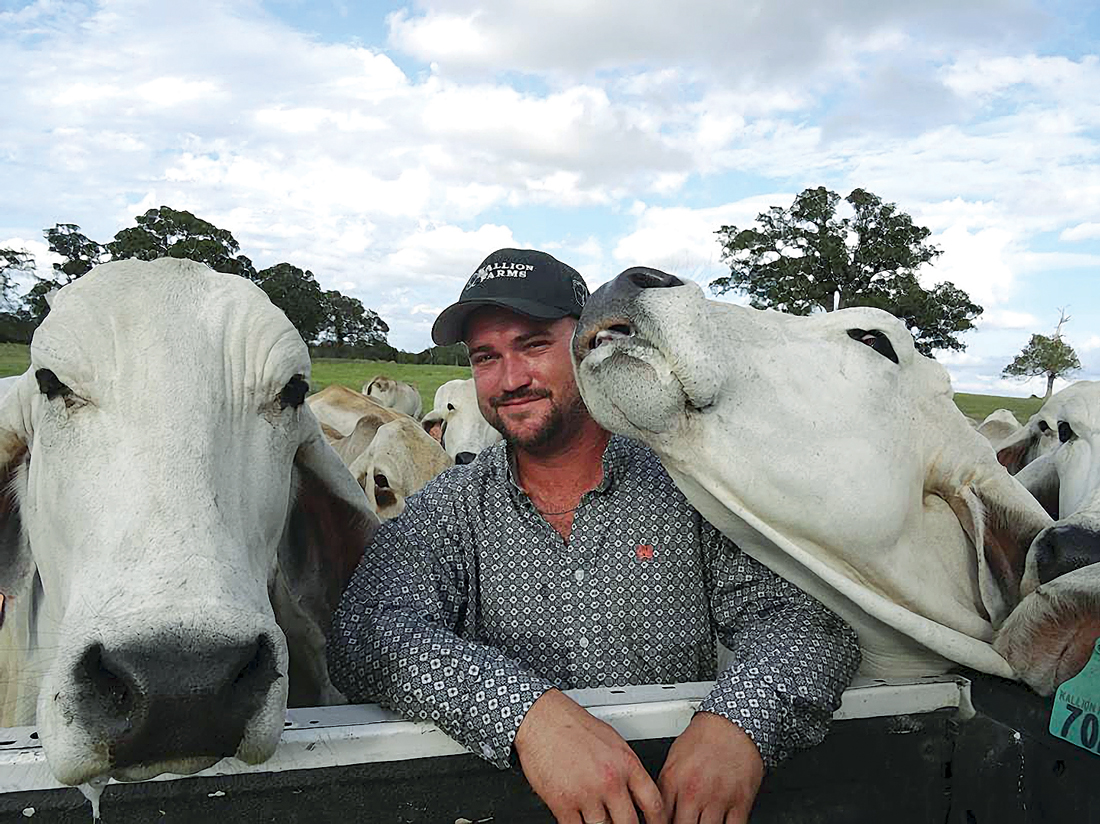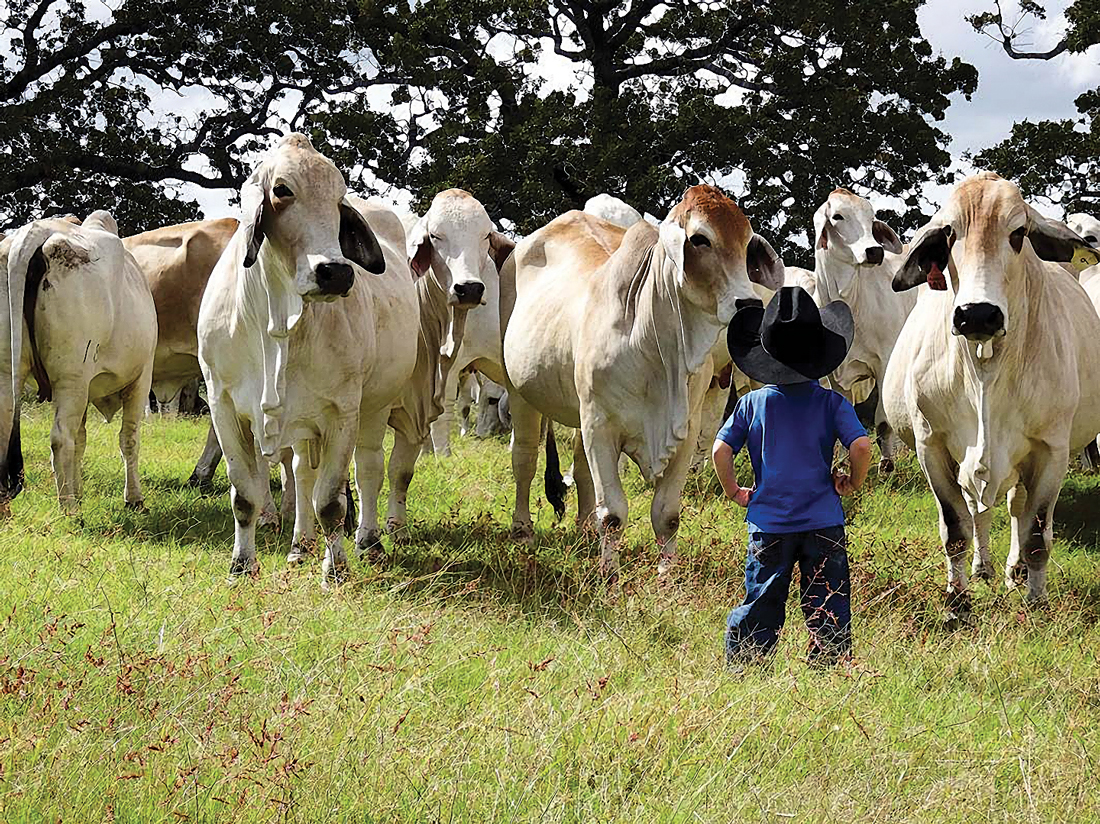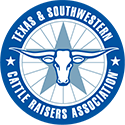Searching for Excellence at Kallion Farms

Why not produce a Brahman that is fertile, tame, efficient and that grades well?
By Maggie Malson, photos provided by Kallion Farms
Kallion means “better” in Greek, and progressive, young cattleman Grant Vassberg has committed himself to making his cattle and the industry better, one Brahman at a time.
The owner of Kallion Farms, a purebred Brahman ranch in College Station, describes himself as driven. “I’m constantly trying to be better,” he says.
That passion for progress was passed down from his father, Byron Vassberg, who became a first-generation farmer and rancher after graduating from Texas A&M in 1986. The elder Vassberg began farming cotton and sugar cane, then added a commercial cattle herd in 1994. Within 4 years, he had grown the herd to 400 commercial Brahman females.
“The Brahman female is a hot commodity,” says Grant Vassberg, of the decision to convert to a registered operation. “She has the flexibility to make tigerstripes, Brangus or full-blood Brahman, so it’s a good investment.”
From the beginning, the Vassbergs didn’t shy away from performance-testing the genetics and using the results to accelerate their herd.
After testing all the steers from the commercial cows, only one went prime. His sire was the only Brahman bull Vassberg owned.
“That was Dad’s epiphany,” Vassberg says. “He realized that Brahmans could compete on carcass merit. A traditional Brahman mentality is that there’s no point in having a Brahman that can perform or grade well because that’s why you have the Angus breed.
“The Kallion approach is why not have both?” he explains. “If you start out with the right Brahman, then cross it with Angus or Hereford, you would be producing very high-quality beef.”
Starting in 2003, the Vassbergs DNA-tested more than 3,000 Brahman cattle, including their own and some additional Brahman cattle from the breed’s most popular bloodlines, to identify which genetics excelled. In 2006, they started collecting feed conversion data as well, identifying more efficient females and potential herd sire prospects. The intent was to improve the breed.
“We found the cattle that had the markers for marbling and tenderness,” Vassberg says. “Then we DNA-tested the offspring we produced from those genetics. Why not produce a Brahman that is fertile, tame, efficient and that grades well?”
Knowing that the global cattle population is made up of more Bos indicus than Bos taurus cattle, Vassberg sees a lot of potential for improving the carcass qualities in the Brahman breed, not only in the U.S. but also across the world.
“We saw there was a real opportunity there,” he explains.
Second generation taking on the ranch
In 2012, the younger Vassberg began making all the breeding decisions at Kallion, taking sole ownership of the operation in 2017. He became quite intense when it came to culling the herd.
“If any animal has a foot, temperament or fertility problem, it’s gone immediately,” he explains. “My customers are commercial cattlemen who rely on cattle for their livelihood. It’s an investment for them and they need to make money. I’m here to improve the traits that are important to them.”
Docility, fertility and carcass qualities remain the foundation and focus at Kallion today.
“When we started our data collection, literally 94 percent of our calves were wild at weaning, but now it’s flip-flopped,” Vassberg says. “About 93 percent of my cattle are extremely docile. It’s shifted the mentality of my customers, too, who always thought the F1s (first-generation Brahman-cross cattle) were wild.”
Vassberg says sometimes he has customers say that the cattle are too gentle, which is actually a good problem to have.
“I had a customer call me the other day and say, ‘Grant, I literally curse you out every day because your Brahmans are worse than my dogs. I open my front door and they’re there. I go to my barn and they’re in my back pocket,’” Vassberg explains. “I really think Brahman is the smartest breed. They’re intelligent beasts, so when you get ones that are naturally docile, and they’re that smart, it’s a cool personality.”
One of the challenges of becoming owner and manager of Kallion was working with a smaller herd than in previous years. To overcome that, Vassberg utilizes embryo and IVF (in vitro fertilization) technology to increase his herd size and he continues his progressive breeding philosophy.
“For me, I would rather go with a virgin female than the 8-year-old proven cow,” he admits. “If I’m doing my job right, then the younger generation should be better. If I wait until a cow is eight years old and proven to flush her, then I feel like I’m just sitting around spinning my wheels.”
He points out that the virgin female donors today are already great-granddaughters of the 8-year-old proven cow.
“I am three generations ahead because I’m not waiting,” he adds.
The big question is, does this philosophy work? Vassberg gives an emphatic, “yes”! The results speak for themselves.

“I’m producing a female with an overall higher marbling score, more massive bone, bigger depth of body, and even more docility,” he explains. “The animals I was high on two years ago are already obsolete because my new generation is that much better.”
Knowing that fertility is important to his commercial customers, Vassberg fine-tuned different matings to work on early puberty.
“Early puberty is something I look for bigtime because I think it’s a very good indicator of how fertile the female is for the rest of her life,” he explains. “Six years ago, our Brahmans were hitting puberty at 17 to 18 months old. Then, fast forward a couple years and it was 15 months old. Now, today, I’m having some hit puberty at 10 months old.”
Some other breeders have asked how Vassberg knows that a virgin female is fertile or how to know if her udder quality is good.
“If she’s cycling at 10 months old, that’s unheard of, and all the females in the pedigree have good udders, so I feel confident she’s going to be fertile and have a good udder,” he points outs.
Feed efficiency and carcass merit continue to be important and Vassberg says his herd remains influenced by all the data collection and testing his father did years ago.
“I’m spending less on feed during the winter,” he explains. “Efficiency had an influence on fertility because the females were able to maintain their body weight and breed back easily. I know the DNA behind it. Fertility and feed efficiency are different, but feed efficiency definitely helps.”
For now, Vassberg markets his purebred bulls and females year-round through private treaty sales. Most of his customers live in the southern U.S., in Texas, Mississippi, Florida and Louisiana. In addition, he has sold Brahman semen to Latin American clients.
Cattle the commercial buyer wants
“I have focused on selling to the progressive commercial cattlemen who want to improve the meat quality of Brahman-influenced cattle,” he explains. “My goal is for them to never have an excuse to sell a Kallion cow. I’m trying to produce go-to cows that really do bring back money and provide a return on investment for the rancher.”
Vassberg says a typical story he hears from his customers is, “Kallion cows have been in my herd for ten years and they give me a calf every year.” That means the females are doing their job.
Hondo Martinez, of Linn, is a satisfied repeat customer. Both cattlemen went to Texas A&M University but didn’t meet each other until a few years after graduation, when Vassberg purchased some Brangus replacement heifers from Martinez. Shortly after meeting, Martinez decided to get into the registered Brahman business.
“I did my research and found that Kallion has done more research on carcass merit and carcass quality to improve the Brahman breed than any other breeder. That’s what really intrigued me and made me want to invest and build my herd using some of their genetics,” Martinez says.
He likes the docility, overall eye appeal, frame size and mass of the Kallion genetics.
“We’re seeing a large-framed animal with plenty of bone and muscle,” he adds. “They have the carcass quality and are really working on fertility, feed conversion, and average daily gain. Those are the traits important to the Brahman industry and we all need to pay more attention to them.”
In addition, Martinez appreciates Vassberg’s progressive nature and his desire for improvement of the breed.
“He’s always trying to make this breed better,” Martinez explains. “He’s not scared to cull a cow for whatever reason. He’s always looking for the next thing to improve on. That’s a good trait to have in this business.”
Searching for Excellence is excerpted from the May 2018 issue of The Cattleman magazine.
